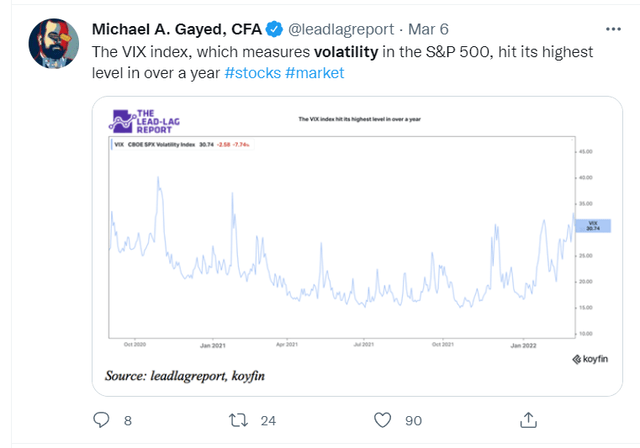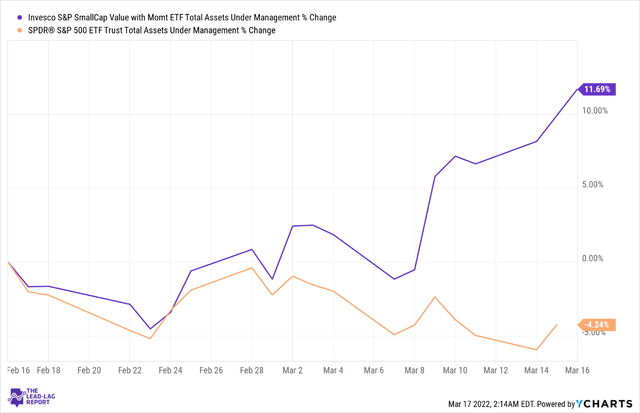NicoElNino/iStock via Getty Images
Sometime last month I had indulged in an enlightening discussion with my fellow market analyst- Jesse Felder on Twitter Spaces; for those of you who were able to listen in, I hope it was worth your time? One of the topics we explored during the conversation was conditions in the small-cap space. If this is a landscape that interests you and you’re fishing for opportunities, then one option you may consider is the Invesco S&P SmallCap Value with Momentum ETF (NYSEARCA:XSVM). As noted in The Lead-Lag Report, volatility conditions have been a dominant theme in recent weeks with the VIX hitting some rather uncomfortable levels.
Typically, during conditions such as this risk assets would likely underperform, but do consider that XSVM has proven to be a popular pick over the last month with its AUM expanding in double-digit terms, even as the SPY has seen a contraction in its AUM. I believe this speaks to the quality of the stock-picking and the fund’s relative defensive qualities, although it remains to be seen if it can continue to hold still when we get a full-blown risk-off environment (currently two of my weekly risk signals are up and two are down).
XSVM’s methodology and portfolio characteristics
XSVM currently offers exposure to around 120 stocks and tracks the S&P SmallCap 600 High Momentum Value Index. Rebalancing takes place twice a year and you’re now looking at a portfolio that saw its most recent rebalancing close by the third week of December.
The index goes through multiple screens to arrive at the final portfolio which consists of small-cap stocks with high “value” scores and high “momentum” scores. In the first step, value scores are computed by evaluating three metrics- a) the trailing book value to price, b) the trailing 12-m earnings to price, and c) the trailing 12-m sales to price. A composite value score is computed and the top 240 stocks by this metric go through to the next round of momentum screening. Momentum scores are based on the relative appreciation of the security vs the other constituents who’ve passed the value test and the top 120 stocks make the final portfolio; weighting takes place on the basis of value scores.
On a stock-specific basis, the ETF comes across as fairly well-diversified with no single stock accounting for a weight of over 2.6%. In addition to that, this isn’t an ETF that is particularly top-heavy as the top-10 stocks only account for just 17% of the total portfolio. I believe this is a useful quality for an ETF to have particularly as idiosyncratic risks tend to be rather elevated with small-cap stocks.
With regards to sector-specific dimensions, it’s no surprise to discover that XSVM is overweight financials; this sector accounts for 36% of the total portfolio, more than twice as much as the next largest sector- consumer discretionary which has a weight of 15%.
When you think about the prospects of banks, you’re looking at a fairly unpredictable landscape. At one end of the equation, it looks as though net interest margins could well be on the way up after a subdued period these last couple of years; The Fed just hiked rates by a quarter percentage point and it also signaled its intention to carry on with this theme during the next six meetings this year. However, at the other end of the spectrum, you also have to wonder about the loan growth prospects of financial stocks as the populace is currently already struggling to stave off spending pressures that come with inflation at 40-year highs. In an environment such as this, consumer spending could slow and result in a dwindling appetite for credit. Under these pricier monetary conditions, you also do wonder if the asset quality of these banks will likely deteriorate?
All in all, you’re looking at a fairly mixed picture for the financials sector. As noted in this week’s ‘Leaders/Laggers’ section of The Lead-Lag Report, a relative strength ratio measuring financials as a function of the S&P 500 has been all over the place in recent weeks, mirroring trends in the treasury market. These yields had begun settling prior to Feb’s inflation report but have recently pivoted quite a bit in just one week.
Summing up…
The recent small-caps performance during a period of heightened volatility has been quite a curious phenomenon to watch, as this was at odds with what one would typically expect; perhaps this is because most of these companies have less international exposure compared to large-caps and currently we’re witnessing quite a widespread bout of global volatility.
Perhaps what is also aiding the small-cap case is the theme of valuation contractions which appear to be quite an obvious red flag for large-caps and not so much for the former. You can get a sense of this with XSVM’s valuations as well, as it currently only trades at a forward P/E of just 8.7x and a forward price to book value of just 1x. Conversely, something like your blue-chip-based SPY trades at a forward P/E multiple of nearly 20x and a price to book value of nearly 3.6x.
 Anticipate Crashes, Corrections, and Bear Markets
Anticipate Crashes, Corrections, and Bear Markets
Sometimes, you might not realize your biggest portfolio risks until it’s too late.
That’s why it’s important to pay attention to the right market data, analysis, and insights on a daily basis. Being a passive investor puts you at unnecessary risk. When you stay informed on key signals and indicators, you’ll take control of your financial future.
My award-winning market research gives you everything you need to know each day, so you can be ready to act when it matters most.
Click here to gain access and try the Lead-Lag Report FREE for 14 days.




Be the first to comment